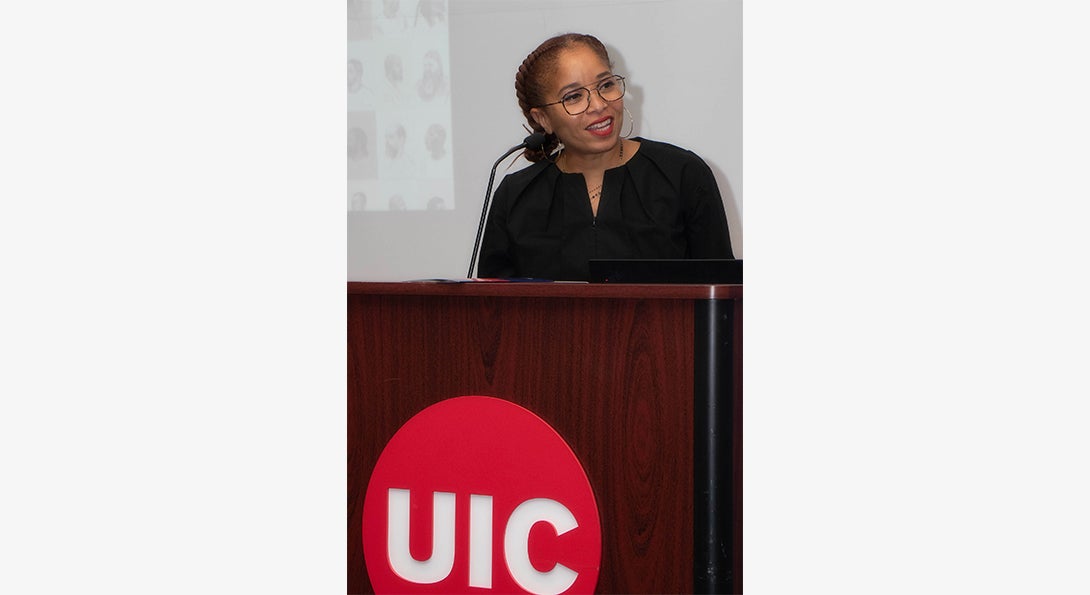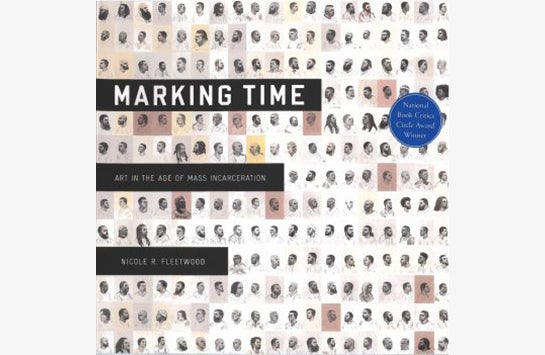Art Therapy

Artists Draw on Prison Experiences to Fashion New Life
Nicole Fleetwood could hear her cousins talking to her in her New York apartment, but she was alone except for the photographs hanging on the walls.
“I often found myself talking to them, trying to bring my cousins, who were incarcerated in Ohio prisons, to life,” said Fleetwood, the featured speaker at the Oct. 10 Shirley M. Buttrick Lecture sponsored by the Jane Addams College of Social Work and the University of Illinois Chicago’s College of Urban Planning and Public Affairs. “I realized by not acknowledging their presence so directly, I was actually reproducing the logic of the carceral state.”
A celebrated writer, cultural theorist, curator, and art critic, Fleetwood, PhD, the Paulette Goddard Endowed Professor of Media, Culture, and Communication in the Steinhardt School at New York University (NYU), is the author of the groundbreaking book “Marking Time: Art in the Age of Mass Incarceration.” A project that began in 2010 with Fleetwood’s personal collection of family photographs taken with relatives while visiting them in prison, the project grew into a large-scale, multi-media art-based initiative that includes artworks by incarcerated individuals and non-incarcerated artists concerned with mass confinement.
“There is nothing I find more inspiring than human creativity,” said Fleetwood, who in 2021 was named a MacArthur “Genius” Fellow, a prestigious designation presented by the John D. and Catherine T. MacArthur Foundation that recognizes individuals who “help us reimagine what is possible” and who “demonstrate that creativity has no boundaries.”
Story continues

Marking Time
Published in 2020, “Marking Time” is based on interviews with more than 70 current and former incarcerated artists, prison visits, and Fleetwood’s family experiences with the penal system. The interviews detailed how the imprisoned artists created their work. In addition to the book, Fleetwood co-curated exhibitions and public programs at MoMA PS1, the National Underground Railroad Freedom Center, Brown University, Aperture, Cleveland Public Library, Mural Arts Philadelphia, Eastern State Penitentiary Historic Site, and Worth Rises, among others, with artworks included in the book.
Some of the artists featured are Tameca Cole, Russell Craig, James “Yaya” Hough, Jesse Krimes, Mark Loughney, Gilberto Rivera, and Sable Elyse Smith. The exhibition was updated with new works to reflect the growing COVID-19 crisis in U.S. prisons.
Artists outside prison walls have tools at their disposal to create their artwork – pencils, brushes, paint, palettes, and paper pads. Prison artists aren’t afforded that luxury. A risk is associated with producing art behind bars, as guards could confiscate any materials. Fellow inmates often smuggle items deemed dangerous – straight pins, etc. – to their friends to construct their masterpieces, which range from graphite portraits, large scale murals, elaborate sculptures, abstract painting, and photo-based collages.
Popsicle sticks, cigarette-pack foil, and recycled tea bags are just some of the reused materials Dean Gillispie has employed to construct small dioramas depicting scenes from his rural Ohio hometown – a gas station, bait shop, old movie theater, Airstream trailer. One of Kenneth Reams’ works, titled “Capitalization,” used wrappers collected from incarcerated individuals sitting on Death Row.
A New York Times Best Art Book of the Year, “Marking Time” won the National Book Critics Award in Criticism, the John Hope Franklin Publication Prize of the American Studies Association, the Susanne M. Glasscock Humanities Book Prize for Interdisciplinary Scholarship, and both the Charles Rufus Morey Book Award in art history and the Frank Jewell Mather Award in art criticism. Fleetwood has also published “Troubling Vision: Performance, Visuality and Blackness,” and “On Racial Icons: Blackness and the Public Imagination.”
Quote
Art transcends time, and as prison artists we make something beautiful out of a horrible situation.
Story continues
Following her presentation, Fleetwood served on a panel to further discuss art and the carceral system. Moderated by Rhea Ballard-Thrower, JD, MILS, dean and university librarian at UIC, Fleetwood was joined by Laurie Jo Reynolds, associate professor of art and art history, UIC; J. Nicole Brooks, Chicago-based actor, writer, director and educator; and via Zoom, James Groleau, a prison artist who has been incarcerated for the past 25 years.
“Art has helped me survive,” Groleau said.
During his incarceration, the self-taught Groleau has painted murals on walls in gymnasiums and visiting rooms, among other areas inside the prisons. He has painted sand castles and other serene scenes to help children feel at-ease while visiting their loved ones and is currently replicating Vincent Van Gogh’s “A Starry Night” on a 4-foot by 8-foot visiting room wall.
Prior to the Buttrick Lecture, a university-wide symposium, “Citizenship, Civil Liberties, and the Carceral State,” was held featuring UIC faculty scholars, students, alums, and community leaders. The morning panel, “Unraveling the Intersectionality of Consequences” was moderated by JACSW Assistant Professor Sara Beeler and Xochitl Adame, MSW, a PhD student at the JACSW. Panelists included Illinois State Rep. Lindsey LaPointe (D-19), MSW; Donald Dew, MSW, president/CEO, Habilitative Systems, Inc., and Paul Rothschild, managing director of operations at the Illinois Coalition to End Permanent Punishments (endpp.org).
The afternoon panel, titled “Unraveling the Intersectionality of Public Policies” was moderated by Aaron Gottlieb, PhD, associate professor at the University of Chicago’s Crown Family School of Social Work, Policy and Practice. Panelists included Teri McMurtry-Chubb, JD, professor, UIC Law; Rahim Kurwa, PhD, assistant professor of criminology, law and justice at UIC; Minister Lionel Muhammad, who spent 24 years incarcerated for a crime he didn’t commit who began the organization Transforming Reentry Services (TRS); and William “Bill” Coats, a JACSW graduate.
Throughout her research career, Fleetwood said: “My biggest takeaway is the creative capacity of human beings under the most austere, oppressive conditions imaginable. I’m so committed to the possibility that artmaking provides to actually moving society forward, towards other ways of being, of other ways of understanding justice and freedom and belonging.”
For Groleau, art is an escape, taking him away from inside a prison to places only he can visit in his imagination.
“As prisoners, time is something we all have,” he said. “Art transcends time, and as prison artists we make something beautiful out of a horrible situation. If it weren’t for the past 25 years, I wouldn’t be the artist I am today.”